The global packaging demand is on the rise due to the booming e-commerce and increased consumer expectations. At the same time, supply chains are also being affected by COVID-19 disruptions, trade conflicts, and material shortages. In fact, a recent survey revealed that 85% of packaging executives will be restructuring their supply chain in 2025, with almost half of them pointing to recent trade tariffs as a key concern. These trade policies, particularly high new tariffs on goods from China, are changing the way businesses source custom boxes, custom mailers, custom labels and other packaging. U.S. companies are experiencing increased prices, longer lead times, and an uncertain cost. This encourages more purchase of American made packaging: no foreign duties, quicker deliveries, and less hassle in compliance. In this report-style blog, we describe the tariffs landscape, the impact it has on costs and logistics, and why the U.S. suppliers such as The Box Lane are a strategic alternative.
Understanding Tariffs – Why Packaging Buyers Should Care
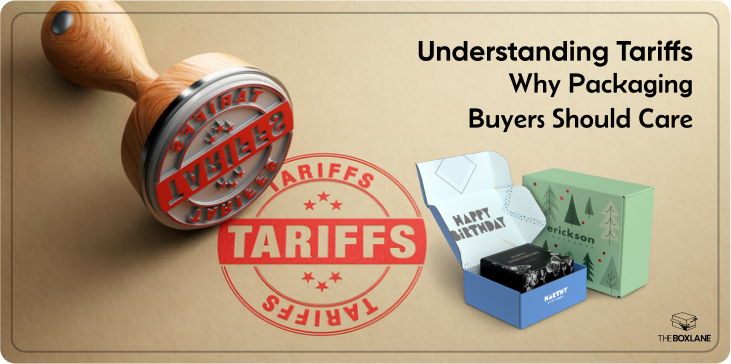
A tariff is a tax on import levied by a government. Tariffs as designed increase the cost of foreign goods in order to protect domestic industries. Tariffs increase the landing cost of all imported products and its raw materials. For packaging consumers, that means that even paperboard mailers or plastic shipping bags can all of a sudden be much more expensive. For instance, at the beginning of April 2025, the U.S. government imposed a “baseline” tariff on all imported items and threatened to increase the “reciprocal” tariffs for trade-surplus countries. The specific rates have been all over the place – e.g. the U.S. tariff on Chinese goods began at 10% in February 2025 and then rose to 20%, 54%, 104%, and finally to 145% by early April. (As of May 12, 2025, both sides agreed to halt the worst of this trade war – U.S. tariffs on China have been reduced to 30% and Chinese tariffs on U.S. products to 10% for 90 days – but 30% is still far above the norms of the past.)
Tariff policies are unpredictable. Industry voices caution that the last-minute rule changes leave the importers with “moving target” pricing. “Managing the tariffs has been a challenge due to sudden policy shifts that cause unexpected expenses”, one packaging executive put it. Tariffs are usually transferred down the supply chain, and importers end up paying more, and often customers find that prices on invoices are higher. Contrary to routine costs, tariffs may be unannounced: A payment made today may be subjected to a new charge when it reaches port. Such uncertainty makes budgeting and pricing very hard for packaging buyers.
Impact on Costs and Logistics
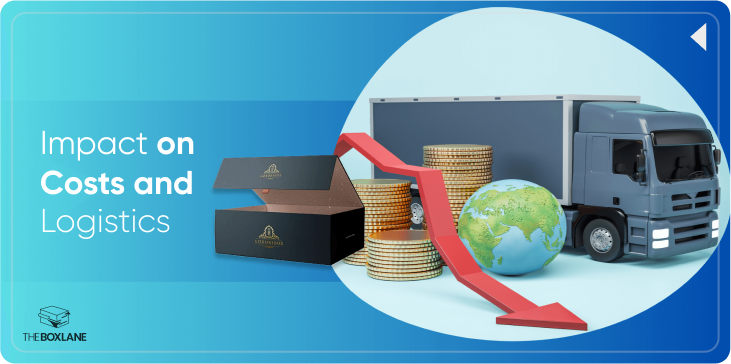
Tariffs directly increase unit costs. For instance, a 25% duty on an imported packaging shipment can tack on a significant surcharge – making a $100,000 order into a $125,000 one. But that’s not all. Importers also face additional fees: custom brokers’ charges, harbor and inspection fees, merchandise processing fees, and possibly demurrage (penalties for when containers are sitting at the port). All these fees “land on finished goods, squeeze margins, and complicate pricing”. In other words, the headline tariff number is an understatement of the actual cost of import sourcing.
Increased material costs have a knock on effect throughout the supply chain. The U.S. packaging producers who use imported raw materials – for example, plastic resins, coated paper, or printed films – also experience an increase in their input costs. Anything that is increased at the manufacturing stage is usually passed on to manufacturers, distributors and finally to the consumers. For example, one study observes that a mere 10% increase in the cost of raw materials (due to new tariffs) may force suppliers to push up the cost of packaging, squeezing companies from producers of food to manufacturers of chemicals. Those companies can then increase their selling prices or incur smaller profits. The tariff is in actual fact placed on the back of the buyer or end customer.
Logistics cost and delay also increase. Overseas transit usually adds weeks. In normal circumstances, freight from Asian factories to a U.S. warehouse takes 30–40 days door-to-door, and sometimes even longer in the peak season. Tariff problems create paperwork delays at the customs and can hold shipments hostage until import duties are paid. Even USPS and courier packages are liable to duties. Couriers are paid on credit and charge the recipient. With high port congestion and inspection backlog, import supply is prone to be erratic. In fact, the holiday shipments declined by 53% between 2024 and 2025 because of these disruptions. These delays are expensive for e-commerce sellers and retail brands. products are delivered late or in partial lots, thus compromising customer satisfaction.
Tariffs increase costs and make everything slow. Experts agree that the cost will probably increase. The prices for raw materials are already going up and any “slight jump in price per unit can add up to thousands or millions of dollars” in the long run. In such an environment, the businesses that depend on imported packaging (for example, cardboard boxes, mailers, poly bags) need to plan for the worst case scenarios of both cost and delay.
Risks of Sourcing Packaging from China
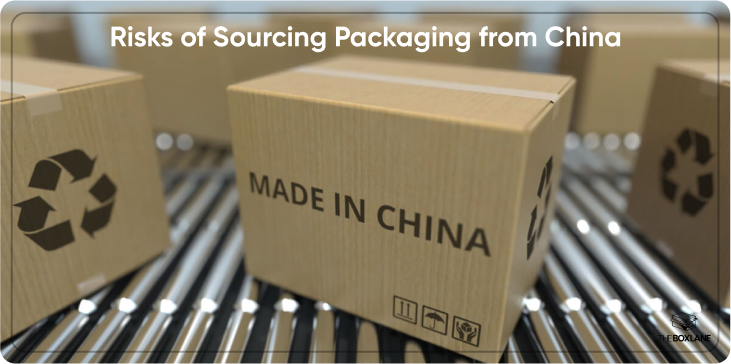
China has been the biggest supplier of low cost packaging supplies in the world for decades. Its factories enjoy ultra low labor costs, huge volume, and inexpensive materials, which traditionally have kept unit prices way down from the U.S. level. Therefore, a lot of companies have a long history of importing mailers, printed boxes, labels, and other custom packaging from China. However, the present trade environment reveals the hidden dangers of this strategy.
First, tariff risk is extreme. A shipment that appeared to be cheap on the factory invoice may attract hundreds of percent in duties. For instance, negotiators of a U.S. packaging company observe that tariffs increased from 20% to 145% on their Chinese-sourced goods in a few months. Such fluctuations can eliminate any price advantage. Even if the headline tariff is put on hold, there can be new, unspecified taxes whenever the trade truce is over.
Second, geopolitical and operational risks are still high. Trade tensions might erupt again (after the 90-days pause), or new conflicts may lead to more barriers. Other occurrences such as Covid shutdowns, shortage of shipping containers, or port strikes can suddenly stop supply. There are some industry reports that indicate 85% of U.S. companies are reconsidering their supply chains due to these trade issues. If the factories of one country stop production (because of lockdowns or policy changes), a dependent business may find itself in a packaging shortage overnight.
Third, long transit times make a mistake or a change expensive. A U.S. buyer may have to expedite an airfreight order or stockout if a Chinese vendor fails to deliver on time. Communication can be tricky too: design corrections or quality problems take more time to solve in a long distance. On the other hand, with a local supplier, revisions and last-minute changes are much easier.
Lastly, quality and standards may be an issue. Although a lot of Chinese factories produce excellent packaging, not all comply with the strict U.S. regulatory or safety standards. Materials or inks that are compliant in China may not be compliant with FDA or EPA rules for food and medical packaging in the U.S. Any compliance slip-up (such as a banned chemical in a plastic bag) may lead to recalls or fines.
Benefits of Purchasing From U.S. Packaging Suppliers
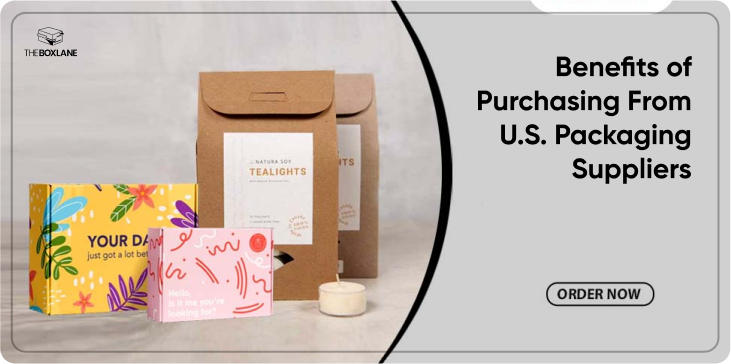
With the above risks, it can be a smart move to buy from U.S manufacturers. There are a number of obvious advantages to locally sourced packaging:
Zero import tariffs
You do not have to pay duties when you purchase from an American company. A new trade policy will not make your price soar out of the blue. This stability makes budgeting easier. As one industry consultant notes, sourcing the packaging at home allows the companies to “avoid import tariffs altogether,” which stabilizes the pricing. In effect, you get tariff-free production – less peaks, less unpredictability in cost.
Shorter lead times
U.S. factories are only days or 1–2 weeks away by truck or rail, not months away by ocean. Consequently, you can make smaller and more frequent orders and decrease inventory. The time savings are substantial: A lot of Asian imports take 30–40 days to arrive, while a U.S. shipment may only take a week or less. Quicker turnaround also translates to quick responsiveness to market changes or a sudden demand.
Eliminate hidden fees
Local sourcing eliminates much additional import cost: no customs brokers’ fees, no port handling or demurrage charges, and no unpleasant surprises in the form of duties. Not even carriers such as FedEx or UPS will charge you duties for imported goods. According to PAC Worldwide, “buying from a U.S.-based manufacturer can eliminate some of the unknowns of sourcing from abroad-located vendors,” including these hidden import charges.
Reliable quality and support
U.S. suppliers tend to be nearby. You can usually visit their facility or at least make face to face meetings. Communication (and time zone) is not a problem, so design tweaks or approvals are faster. American manufacturers are subject to strict federal and state standards (FDA, ASTM, environmental rules, etc.), so compliance is inbuilt. Many also have certifications such as ISO quality or FSC/PEFC for sustainable materials. In practice, collaboration with a domestic supplier means that there is somebody at hand who supports the product.
Better customer service
For example, Box Lane is proud of “experience and expertise” in custom packaging. American companies usually provide design consultation, fast digital proofs and low minimums. The Box Lane includes such perks as “free quote, free shipping, & more” and 10-day production guarantees. Such support can be priceless for a developing e-commerce or food brand.
Supply chain resilience
A local supplier means that your country has the packaging supply chain. That protects from global disruptions’ risks. When one of your factories malfunctions, your supplier will not be at the same time affected by the same problem. As a matter of fact, many firms have diversified or moved their production because of this reason. A-ROO Company (U.S packager) emphasizes Ohio plant as an advantage in uncertain times: “What makes us different… is that we are able to develop cost-effective and high-quality products at our own production facility in Ohio,” says their supply chain director.
Supporting local economy and brand image
Nowadays, many firms advertise their products as “Made in USA” or “American-made packaging”. This appeals to customers who are concerned with domestic jobs and lower carbon footprint. As Ashtonne Packaging observes, domestic sourcing “bolsters a stronger local economy” and attracts consumers who like the idea of U.S. manufacturing. American packaging may be a selling point in itself.
Sustainability and compliance advantages
American packaging plants are bound to strict environmental regulations. This usually means cleaner manufacturing processes and increased recycling rates. Scholars have observed that the U.S. environmental regime is “far superior to China’s,” which puts U.S. businesses at an advantage in terms of developing cleaner methods of production. Collaboration with U.S. suppliers also makes it easier to comply with new sustainability legislation. For example, extended producer responsibility (EPR) rules – that hold manufacturers accountable for packaging waste – have been implemented in such states as California, Colorado, Maine and Oregon. Domestic suppliers are already manufacturing products to comply with these laws, so your packaging is more likely to be recyclable or compostable without the legal hassles.
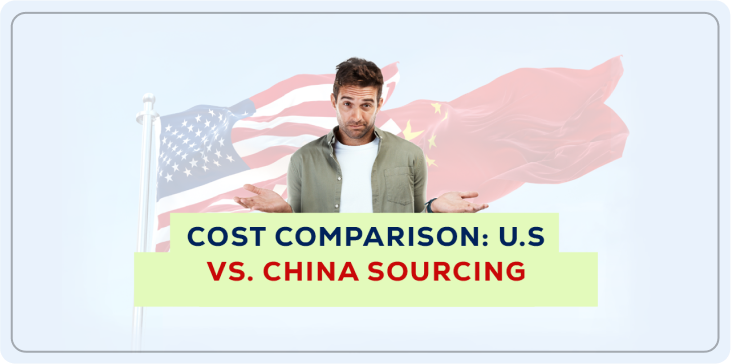
Cost Comparison: U.S. vs. China Sourcing
|
Cost Factor |
U.S. Supplier |
China Import (with Tariffs) |
|
Base price (per unit) |
e.g. $2.00 (domestic labor) |
~$1.60 (20% cheaper labor) |
|
Tariff on imports |
0% (domestic) |
+25–145% (depending on country/status) |
|
International freight |
Minimal (truck/freight inside US) |
Significant (ocean freight + inland delivery) |
|
Lead time |
~1–2 weeks |
~4–8+ weeks (port congestion, handling) |
|
Total landed cost (ex.) |
~$2.00 + $0.05 domestic fee = ~$2.05 |
$1.60 + $0.40 tariff + $0.30 freight ≈ $2.30 |
Example: A box with a $2.00 domestic base price and a lower $1.60 Chinese base price. With U.S. sourcing you would pay ~$2.05 (domestic freight). With Chinese sourcing, a 25% tariff ($0.40) and shipping ($0.30), the cost is up to ~$2.30 – more overall. In effect, tariffs of 54%, 104% or even 145% (on some Chinese imports) would make the imported box extremely expensive. This is what a recent industry report puts it: A 25% tariff on imported packaging can make a $100,000 shipment into a $125,000 liability”.
The above table is illustrative; it shows how landed cost can benefit U.S. supply once all factors are taken into consideration. In most instances, a locally made box is cost competitive or even cheaper when you factor in duties and expedited freight, hidden fees.
Eco-Compliance and Sustainability Benefits of U.S. Packaging
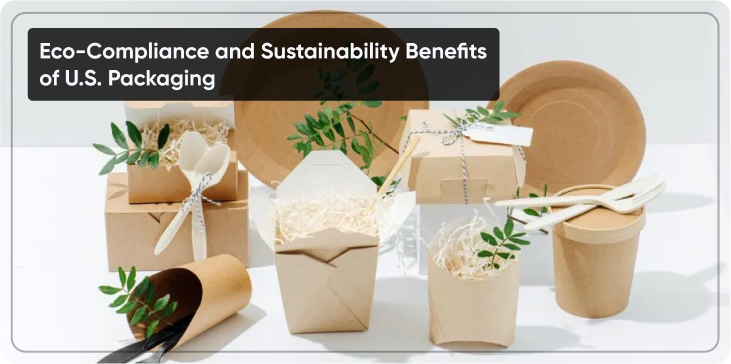
Environmental issues are becoming more and more important for both businesses and consumers. The U.S. packaging manufacturers are often the leaders in sustainability. They use recycled content, and certify materials (e.g. FSC-certified paperboard), and design for easy recycling or composting. This not only satisfies customer expectation but also guarantees adherence to changing rules. For instance, a number of states have banned some single-use plastics and are enacting extended producer responsibility (EPR) laws that make companies pay for packaging recycling. Working with an American supplier means that your packaging is likely to meet these standards already.
Research indicates that sustainable packaging can enhance brand image and reduce wastes. American producers also tend to focus on “waste reduction, regulatory compliance, [and] brand enhancement” as primary benefits. Some overseas producers, meanwhile, have less stringent environmental requirements (one study said the U.S. regime is “far superior” to China’s). In other words, U.S. packaging has a less carbon and pollution footprint. When “buying American”, you not only avoid tariffs but also can reduce indirect costs (such as carbon taxes or penalties) and improve your green credentials.
How to Transition to the U.S. Packaging Suppliers?
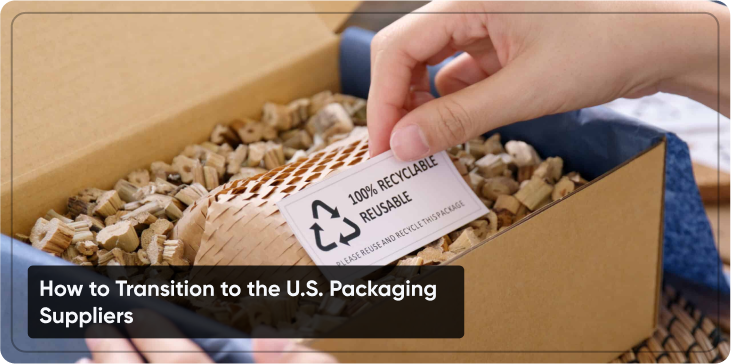
Changing to a domestic supplier of packaging requires planning. Here are some steps:
- Review Your Current Spend. List all your packaging components that you import (e.g., corrugated boxes, poly mailers, labels). Note quantities and costs.
- Contact U.S. Suppliers. Contact reliable American manufacturers. For example, Box Lane provides free consultation in design and minimum orders. Ask for quotes and free samples on your designs. Compare prices with all fees (tariffs you would avoid, shipping fees, etc.).
- Compare Total Cost. Assess landed cost and lead time of the U.S. versus overseas choices. Do not forget about the import duties and delays for the foreign quotes. In most cases, the U.S quote may be the same or even lower when you factor in all the costs.
- Pilot Orders. Make a little trial order from a U.S. supplier. Use it to test print quality, material and speed of delivery. This risk-free test can create confidence. Many suppliers such as The Box Lane provide sample boxes so that you can check quality before purchasing in bulk.
- Plan Inventory and Transition. If you have a stock of imported packaging, plan a phase-out. Keep enough stock to cover the switch-over period and then begin to order domestically as stocks are depleted.
- Update Procurement Policies. Update your supplier contracts and procurement rules to include American-made packaging. This can ensure that tariff protection is secured in the future.
- Leverage Partnerships. A full-service partner such as The Box Lane can make the change easier. They can help with package design variation, speed up production, and recommend sustainability. Use their expertise to ensure that the transition is seamless.
Conclusion
Tariffs and trade tensions have brought in unprecedented uncertainty to the packaging industry. American enterprises that used to benefit from cheap imports from China are rethinking their strategies. The purchase of American-made packaging is quickly no longer a patriotic move, but a sensible one. By procuring locally, companies avoid heavy duties, reduce lead times, and make compliance easier – sometimes at a competitive price. “There is no better time than now to buy American-made products”-said one packaging leader.
If you are an e-commerce retailer, a food manufacturer, or any company that requires custom boxes or mailers, it is now the time to look for U.S. suppliers. The Box Lane has assisted thousands of brands with fast turn, high quality custom packaging. Having 8+ years of experience, a team of packaging specialists, and client-oriented services (such as free delivery and quick production), we can help you through your transition. Contact us today for a free quote or sample. Let us demonstrate how American-made packaging can help you to keep your margins, accelerate your deliveries, and be eco-friendly.
FAQ
Q1: What is a tariff? How does it affect my packaging costs?
Tariff is a government tax on imports. If you import packaging materials or products, you are to pay these duties. Tariffs increase your landing cost, for instance, a 25% tariff on an order of $100 makes it $125 cost. That extra cost is normally charged to your invoice and so you end up paying more for each box, mailer or bag.
Q2: Why have packaging costs gone up recently?
In 2024-2025 a number of large tariffs were introduced on the goods from such countries as China. U.S. tariffs on Chinese products had increased to 145% by April 2025. These hikes, and fees (brokers, fuel, etc.) have meant that import prices have skyrocketed. Furthermore, global shipping delays and increased prices of raw materials (usually because of tariffs) have also increased the overall cost.
Q3: Can importing from other countries still be cheaper?
Pre-tariff, yes – Chinese and other Asian producers tend to have lower base prices due to cheap labor and giant factories. However, after you add tariffs (sometimes 25–145% on top), the increased freight costs and fees, the savings often disappear. In most cases, the landed cost of a U.S box is either the same or even lower than an imported one when you include all costs.
Q4: What are the benefits of US-made packaging?
Purchases from U.S. sources imply no import duties, reduced lead times (days or weeks instead of months), and quicker reaction to design changes. U.S. plants conform to the American quality and environmental standards, and usually offer better customer support. You also reduce risk: no surprise tariffs and fewer possibilities of shipping delays. Moreover, many customers like “Made in USA” branding that can improve your image.
Q5: How does US packaging help with sustainability?
U.S. manufacturers tend to utilize recycled or compostable materials and are up to date with eco-regulations. For instance, new laws in states such as California and Maine require companies to deal with packaging waste (EPR laws). Domestic suppliers already design products to these rules. Also, US environmental standards are more stringent in most export countries and so US packaging has a smaller carbon footprint.
Q6: How do I switch to a US packaging supplier?
First of all, list your current packaging requirements (types, quantities, specs). Then contact U.S. companies for quotes and free samples. Compare the total cost (and time) including what you would have paid in tariffs. Try a trial run order with a domestic supplier to check the quality and speed. A company such as The Box Lane can provide design help, low order minimums and fast turnaround. Ease into it by burning your imported stock and replacing them with domestic orders.
Q7: Why choose The Box Lane?
The Box Lane is a veteran American custom packaging supplier. We provide flexible small-batch production, short lead times (as short as 10 business days for qualified orders), and a lot of support (free design consultation, free delivery, etc.). Our U.S.-based team knows the effect of tariffs and is willing to assist your business in adapting to them. Get a quote today and find out how The Box Lane can save you from the surprises of the supply chain and can help you build your brand.


